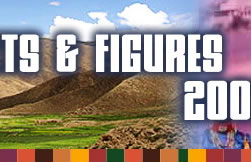|
Historically, Tibet has been a windy and dusty place. In recent years, affected by the global warming and the enlarging hole in the ozone layer, Tibet has begun to see a raised snow line, dried up lakes and degenerated grasslands. To effectively check and treat grassland degeneration and land desertification, Tibet is striving to build a massive forest and grassland ecosystem, which is based on the realignment of rivers and focuses on the treatment of small watersheds and deteriorated pastures. By combining the growing of grass and trees with closing hillsides (to livestock grazing and fuel gathering) to facilitate afforestation and aerial seeding, trees and grass are planted near rivers and in areas suffering from serious pasture deterioration and desertification, in a bid to restore the vegetation. In the upper reaches of the Yangtze River, efforts include the protection of natural forests, transformation of farmlands back to forests or pastures, and conservation of wetlands. Trees and grass are also planted around the city of Lhasa. In major agricultural areas, it is urged that farmlands are integrated with shelterbelt networks in order to reduce the erosion of sand to soil. All these measures have significantly slowed down the pace of land desertification in Tibet.
The year 2000 saw the issue of the Ecological Environment Construction Planning of the Tibet Autonomous Region 2000-50. According to the planning, Tibet will invest a total of 22.7 billion yuan in construction of the ecological environment in 50 years. The massive plan will be carried out in three phases with 160 key projects, focusing on the comprehensive treatment of the ecological environment in the middle reaches of the Yarlung Zangbo River in south Tibet, which includes the building of ecological agriculture and the restoration of degenerated grasslands. Meanwhile, efforts will be made for the treatment of soil erosion and protection of natural forests in east Tibet and the ecological construction of grasslands in the northeastern and northern parts, where pastures are threatened by desertification, deterioration and alkalization. It is expected that the plan will help gradually control the deteriorating ecological environment in Tibet and eventually enable the region to step into a benign cycle regarding the utilization of natural resources and the evolution of ecological environment.
|





